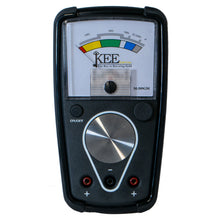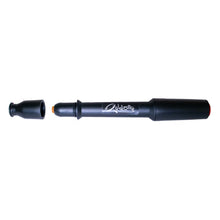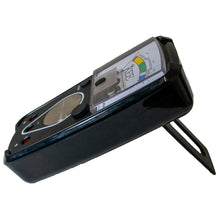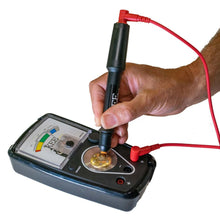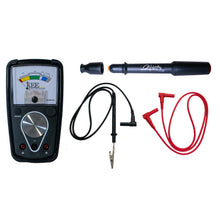
Pickup available from Quicktest (WD18 8JA)
Email us
or call on 01923-220206 for appointment.
Summary
Special price, offer ends 11am Monday 2 December.
In stock and available for immediate UK dispatch (unlike other suppliers, we don't take your money then order it from overseas!). Includes pen-probe.
Making it with a simple analogue meter seems to have solved the problems found with 'computerised' electronic gold testers. This is definitely the most reliable electronic tester we have seen.
The price does not include a sample of 18ct and 22ct. If you deal in jewellery you will have these - if not, you will need the 18ct sample for testing general jewellery; plus the 22ct sample if you want to test above 18ct accurately.
Guarantee: 1 year
Detail
- Size 90 X 170 X 50mm (3.5 X 7 X 2 inches)
- No acids involved, the probe contains a harmless salt solution.
- Tests gold from 8ct to 24ct (the scale is marked "K" instead of "ct" because it's American)
- The pen-probe provides up to 3000 tests.
- Simple analogue meter, good reliability
- Simply touch pen probe to the item, result is shown in 2 or 3 seconds, very fast
- Includes extra contact leads for large items that will not fit on the test-plate.
- Easy calibration with a sample of 18ct (+ a sample of 22ct gold if you want to test above 18ct accurately) - not included in the price of the tester
- As with every tester (whether you spend £15.00 or £12,000.00) it only tests the surface. This means you must file the surface with a fine needle-file (supplied with each tester) in a place where it won't show, to remove any surface plating.
INCLUDED:
- Battery
- Diamond-impregnated file
- Very clear illustrated instruction booklet written by QUICKTEST
- An extra set of leads for testing very large items that will not fit on the test-plate (though we have never known anyone who has needed to use these).
White Metals
SUMMARY
The KEE tester works best on yellow gold. On white gold It will (providing the item is filed thoroughly) tell you if it is gold but will not necessarily give an accurate carat reading; it will also (providing the item is filed thoroughly) tell you if it is platinum.
DETAIL
Silver reads as not gold.
Steel or tungsten can read as high-carat or as platinum if it is not filed first; once filed it should read not gold.
White gold with a high nickel content will give a reading that is too low; white gold containing Palladium, or with a high silver content, will give a reading that is too high.
Pure Palladium will read somewhere between 18ct an 24ct (be suspicious, 22ct+ gold an only be yellow).
Rhodium is used as a plating to improve the colour of the gold. If you don’t file it, it will test as platinum; if you file it slightly, the tester will pick up both rhodium and gold and the reading will be too high; if you file it thoroughly, the test will be more accurate.
Extras
Also included, the following free gifts (these don't come as 'standard'):
- Carrying pouch
- Mini hallmark chart
- Gold-polishing cloth
and you will have the option of selecting a free gift! (online orders only).
OPTIONAL EXTRAS:
A pen-probe is included, if you want a spare, select it from "Optional Extras".
To test 9ct to 22ct you will need a sample of 18ct yellow gold (it must be exactly 18ct). This is to 'match' the electronics in the tester to the carat (technical term: calibrate). You cannot use the tester without this.
If you want to test 20ct to 24ct accurately you will also need a sample of exactly 22ct.
You can use anything with a UK hallmark or you can add one (or both) calibration samples to your order, click on View Optional Extras.
UK traders will already have hallmarked items, which is why we don't include the calibration samples in the price of the tester.
Reliability
The tester is guaranteed for one year.
- the level of returns is 2%, of which half turn out not be faulty at all (used-up probe, flat battery, out of calibration).
- we do find that many are faulty when we receive them from the supplier in the USA. We return these to the supplier, we do not sell them. Unlike other companies, we open and test every one thoroughly That's why we have such a low level or returns; that's why we have such good feedback.
Pen-probe
A pen-probe is included with your purchase, if you want a spare, click on View Optional Extras. A pen-probe is guaranteed for one month.
The pen-probe is like a felt pen, if you don't replace the cap firmly it dries out. The manufacturers say it will give "up to a few thousand tests" (which could mean any number less than this). They also say it should be replaced after a year (a year from the date on its sticker).
Comments from customers:
- The KEE tests on average about 40 items a day and the probe lasts about 6 months, 5000 tests. The solution in the probe outlasts the tip which becomes soiled from testing scrap. We replace the probe when reliability drifts and more regular calibration is required with our 18ct control sample.
- We get around 3 months and test around 10 times a day, often 15 times a day. Overall we think they last well.
- Our probe only lasted 3 months, we are very disappointed.
-
It's variable, some probes last approximately 12- 18 months each (about 2000 tests) and some 9 - 12 months (about 1000 tests).
- The probes seem to last us at least a year, I would say that it was at least 200 individual tests, and perhaps even up to 400 tests over that period.
- Sometimes a probe lasts a few months but sometimes only a few weeks.
Conclusion:
- Generally, a pen-probe lasts between 3 and 18 months but it can be as long as 2 years or as short as 6 weeks - the guaranteed is one month from the date of purchase.
- Although the manufacturers recommend you change it after a year, if it's still working, it's fine. Providing you are still able to calibrated the tester, you will get accurate results.
- The date on the sticker on the pen-probe is so that we know which batch it comes from and so that you have an idea when it's getting to be a year old. Irrespective of the date on the sticker, the guarantee is one month from the date you purchased it.
Disclaimer
All testers must be used in conjunction with the user's skill, knowledge and experience. Under no circumstances shall QUICKTEST be liable for direct or indirect loss sustained in connection with any item. Nothing is 100% accurate, you must understand the limitations of any tester you buy. Full support given for items you buy from QUICKTEST.
More information
Click here for more details and a review
Click here if you already have a KEE tester and need a replacement pen-probe.
Click here see how easy it is to use, download a copy of the instruction manual (.pdf). Compare this with the instructions for other electronic testers!
Free gift details
If you would like one of the following free gifts with this product, select one from “Select your free gift” above.
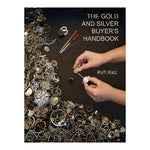
|
The Gold & Silver Buyer's Handbook (RRP £12.50 ) |
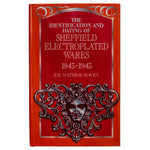
|
The Identification of Sheffield Plate (RRP £7.50 ) |
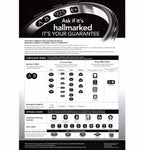
|
Official hallmark chart, UNMOUNTED (folded) (RRP £3.90 ) |
QUESTIONS & ANSWERS
Ask a Question-
Hi I am interested in this machine but it seems to only shown starting from 10 carat up to 24 carat on the display, as you know a lot of uk jewellery is 9 carat, how does it identify this if there is no 9 carat display on the machine?
Anywhere in the "10Kt" (yellow) section of the meter means 9ct, the needle might settle towards the bottom - but anywhere in this section indicates 9ct.
The Kee tester is made for the American market. They have 10ct rather than 9ct, and also they spell carat (ct) "karat (Kt)". -
Soo Does this Test Just Check the Surface of the Gold? or does it Check the Gold All the way thru?...Like a Gold Bar...Because knowing just the Surface is nothing and not Worth $350 just to know the Surface when it could be Heavy Plated..
All electronic gold testers (i.e. that tell you the carat) only test the surface; you must file the surface with a fine file (included) so that you are testing below the surface. There are no exceptions, this applies to the inexpensive electronic gold testers (£450.00) and it also applies to the XRF testers ("cheap" models from £12,000.00, "good" models £40,000.00) and it also applies to acids (about £50.00 per set).
If you ONLY deal with gold bars, get an ultrasound detector, this will tell you if the bar is the same all the way through or if there's another metal in the middle. These will not tell you if the bar is gold, it is not a gold tester (and they cost about £1000.00, and I see you say a tester is 'not worth $350.00"). -
Hallo, Can you calibrated I want to test 18k 21k 22k
We calibrate these before dispatch for ALL carats (9ct to 24ct).
As the fluid in the pen gets used up you will have to keep calibrating it yourself but, to begin with, it's all checked and calibrated and ready to go, you dont' have to do anything, it will work from 9ct to 24ct. -
Does the Kee test all the way through a gold sample or just part the way through?
Electronic gold testers (of any type, any make) do not test all the way though the gold; neither do they test partway through, they just test the surface. That is why you must file the surface first (a fine needle-file is included with the tester) to remove any gold plating.
An ultrasound tester will tell you if an item is the same all the way through or if it is 'filled' with another metal in the middle. They are used on coins and bars. They are advertised as 'gold testers' because if you have what looks like a gold bar or a gold coin, you will assume the 'outside' is gold, and you might want to know if it is contains a totally different metal in the middle, HOWEVER, and ultrasound tester will ONLY tell you if you have a metal object with another metal hidden in the middle, it will not tell you if any of it is gold! We do not sell ultrasound testers. -
Can the KEE electronic gold tester be used straight away to test up to 9ct anything higher will need to be calibrated with 18ct - 22ct.?
It is supplied thoroughly tested and calibrated, it can be used straight away to test any carat.
Unlike other brands, you are not required to calibrate it every time you use it.
As the fluid in the pen-probe gets used up, the readings become inacurate and then you have to keep calibrating it (you will need a calibration sample, calibration takes about about 5 seconds).
Obviously, we recommend getting a calibration sample (either from us, or any scrap hallmarked item) sooner rather than later.
The calibration sample should be 18ct. You only need a 22ct sample (in addition to the 18ct sample) if you want to test 20ct to 24ct accurately. -
Does the tester tell you non gold?
The short answer is: yes. But it depends on what you mean by "Does the tester tell you non gold".
The tester tells you how much gold is in the metal alloy (the percentage purity, but measured in "carat" rather than "percentage").
So if you see that the amount of gold is zero (the red section of the dial)...then the metal does not contain any gold, it is "non gold".
So the answer to your question, ""Does the tester tell you non gold" is: yes.
If, by "Does the tester tell you non gold" you mean: if you can see the metal is not gold will it tell you what it is made of?
Then the answer is: no.
If you want list of all the metals in the alloy (whether gold or non gold) get an XRF tester, prices start at £12,000.00. It is common for companies to get a set of acids for each store and an XRF tester for Head Office. We do not sell XRF tetsters.
If, at this point, if you are confused because you don't understand that the metal will be an alloy (in the case of gold jewellery and coins, a mixture of gold and other metals) or you don't understand 'carat', or you don't understand what can legally be described as 'gold' in the UK - then you need The Gold & Silver Buyer's Handbook. -
Do you supply the replacement probes in the UK and how much do they currently cost?
Yes we sell the probes, £49.50. Yes we hold stock here in the UK, "1 to 2 day delivery" available.
-
Do you calibrate this device before despatch?
Yes, every tester is carefully checked and calibrated before dispatch.
This is something other suppliers don't do, they just post it to you and hope it works. -
Does it come with a case. Also Do we have to replace fluid in the pen or buy a new pen.
It comes with a carrying pound, see product description.
You replace the pen, see product description.
-
Hi does the tester test for platinum or silver or palladium
Platinum - yes. Providing the surface of the item is filed thoroughly, not only to get through any plating but also to be certain there is no contamination, then it will test for platinum.
Silver - no.
Palladium - no. -
Hi, will this test Rhodium plated items
The short answer is yes.
The long answer is: you always have to file the item (a very fine file is included) to remove any plating, so that you are testing whatever is underneath. This applies to all gold testers.
-
Regarding the Calibration samples for electronic gold testers, do I have to file them for calibration? Alos, regarding smelted placer gold, do I have to file them for calibration?
File it lightly just to make sure it’s clean and bright. No need to file it deeply, we know the calibration sample isn’t plated.
Similarly, for smelted items, the surface must be bright and shiny and clean. If you are a professional smelter, it will be homogenous (the same all the way through) and solid. If you are an amateur, it might not be homogenous and it might be 'bubbled' (like honeycomb) in which case it will be difficult to test. -
Will this test 24kt 12.5kg bars accurately. Are they suitable to take that weight? Thank you
Yes it will test large items that don’t fit on the ‘test plate’. There’s an extra set of leads especially for this purpose.
Be aware that any electronic tester (even if you pay £20,000.00) only tests the surface so you need to file it (to get underneath any plating) and also you will not know if it is gold all the way through.
-
Can you test metals that have been found on the beach with this machine? Like solid lumps of metal?
Yes it will work with any “solid lump of metal” even if it’s found on the beach. It must, of course, be a solid lump of metal, and you will have to clean off any surface contamination.
-
Does this have batteries
Yes.
-
Once the pen dries can it be restored with fluid or does it need to be replaced?
No, you can’t refill it with fluid, you have to buy a fresh probe.
-
Hi. Does this also test white gold?
Generally, yes but the readings tend to be a little too high...though sometimes a reading can be a little too low. To see how the readings vary with different white metals, go to the product and click on the tab White Gold. It works best on yellow gold.
-
Hi I have one of these machines. Recently, when calibrating with 18ct gold, the pointer goes to 22 ct. , and the adjuster will not turn anti-clockwise in order for me to bring the pointer down to 18ct. Can you please help.
This means it needs a new pen probe.
-
Hi. I wondered if you supply a silver testing machine, I can’t seem to find one anywhere butt I know they do exist. There’s a lot more people dealing in silver now it’s become So popular over the last ten years. Any help much appreciated, cheers mark
I don’t know of a low-cost (under £10,000.00) tester for silver. I suspect that it would be possible to develop one but silver is low-value and not many people would want to spend £400.00 or £500.00 on a tester. Every silver dealer/collector SAYS they want this machine, but I have my doubts as to how many would actualy spend the money.
-
Will the KEE tester detect Pyrite
Yes, it will tell you it’s not gold.
-
You mentioned using this together with ultrasound tester, could you recommend your personal favourites or recommendation of ultrasound testers? Thanks
We do not sell ultrasound testers, have never used one, and I have no recommendations. Here is some general advice.
a) an ultrasound tester won’t tell you if the metal is gold, you still need to test it with a gold tester. An ultrasound will only tell you if the item is not homogenous (the same all the way through).
b) It’s very complicated to test coins
c) you have to supply your own micrometre and take accurate readings, and must then take the ultrasound measurement exactly through the measured part. This is difficult with coins (you might have to take several readings) and impossible with uneven-shaped bars.
d) the tester, itself, doesn’t give a meaningful reading, it needs to be used with an app. I don’t know how easy it is to use the apps.
e) ultrasound testers cost between £750.00 for a ‘general engineering’ model, to £1500.00 for one that’s specifically for coins and bars. -
Hi,do you have to put probe on the part you have filed when testing
Yes, you put the probe on the area you have filed. The part of the item resting on the test-plate does not have to be filed.
-
May I ask what the crocodile clip is used for in this machine? and how is it being used when testing gold?
It is for testing items that are too large to fit onto the test-plate. It is unlikely that you will ever use this for testing jewellery.
If you are the person who bought a Kee tester a few days ago (we can only see your first name on our system) - please read the instructions. -
Can I Check white gold ?
It’s not as accurate on white gold, it's designed to test yellow gold.
Theoretically, white gold reads a bit too high. On our samples 9ct white gold is correct, 14ct white gold reads “18” and 18ct white gold is correct
The best test for white gold is the acid test which will distinguish white gold, steel, platinum and Palldium. -
Hi will this test Platinum?
The short answer is: no.
The long answer is:
- it has a "P" for Platinum reading. However, that does not mean it is platinum. It might be platinum...but it might be Palladium. This is why we do not advertise this as being able to test for platinum. -
I am interested in buying a reliable gold tester as we are starting to get a lot more gold coins, unmarked jewellery etc. We have an acid tester, but I am not a fan of filing good jewellery and especially proof coins in order to put acid on it. I do understand that no gold tester can test 'through' the surface, but do you have something that tests the surface without leaving any kind of mark such as an acid stain? We cannot afford an expensive XRF gun. Does the KEE leave any kind of surface mark as an acid tester would?
You touch the pen-probe (it’s like a felt pen) onto the gold; the pen-probe is filled with a salt solution.
For jewellery you must file the item so that you are testing underneath any plating (you must file the item even with a £12,000.00 XRF tester)
For coins, it depends.
If it’s definitely a scrap coin, then file it anyway.
If it’s a collector’s coin, it is up to your expertise to decide if the coin is genuine, you would not want to file it.
The salt from the pen-probe doesn’t leave a ‘stain’ in the way that acid does but it might leave a slight residue of salt, and although this wipes off with a damp cloth, you would not want this on a proof coin (where even a slight fingerprint is a no-no!) – so you cannot test PROOF coins.
-
Does it test silver or any other metals?
It only tests for gold.
It also has a "P" reading, this could be platinum or Palladium (it could be either, you won't know which). It does not test for silver, it does not test for any other metals.
Obviously, it will tell you if an item is "not gold" but it won't tell you what it is. -
How do you test a gold chain as the test plate seems too small
Only the part you are testing needs to rest on the plate, it doesn’t matter if most of the chain is not on the plate.
For items that are REALLY too large to fit on the plate (I can’t think of any jewellery that would be too large!) there’s an extra lead with a clip so that you don’t have to use the plate at all.
-
Where do you file a gold ring for testing so it dosnt show
On the inside of the shank.
-
I Live in Denmark and we use 8kt gold as the lowest, can it also show that low kt ?
SHORT ANSWER: Yes it will test 8ct.
We have a sample of 8ct (though we've also tested it on an XRF tester and it's actually 8.3ct) - the needle goes to 1/5 the way up the "10Krt" (yellow) area on the Kee meter. So, for you, if the needle goes into the 10Krt" (yellow) area even a tiny bit, it's 8ct.
LONG ANSWER:
By comparison, we get the following readings:
9ct gold with the remaining metals in the alloy being mostly copper: the needle goes to 1/4 the way up the "10krt" (yellow) area on the Kee meter.
9ct gold with the remaining metals in the ally being mostly silver: the needle goes to 1/2 the way up the "10krt" (yellow) area on the Kee meter.
9ct white gold: the needle goes to 3/4 the way up the "10krt" (yellow) area on the Kee meter (white gold always registers higher than yellow gold)
CONCLUSION:
Anywhere in the "10krt" (yellow) area of the meter indicates between 8ct and 10ct, with the probability that the lower the reading the lower the carat, but not accurate enough to exactly distinguish between 8ct and 9ct, or between 9ct and 10ct.






